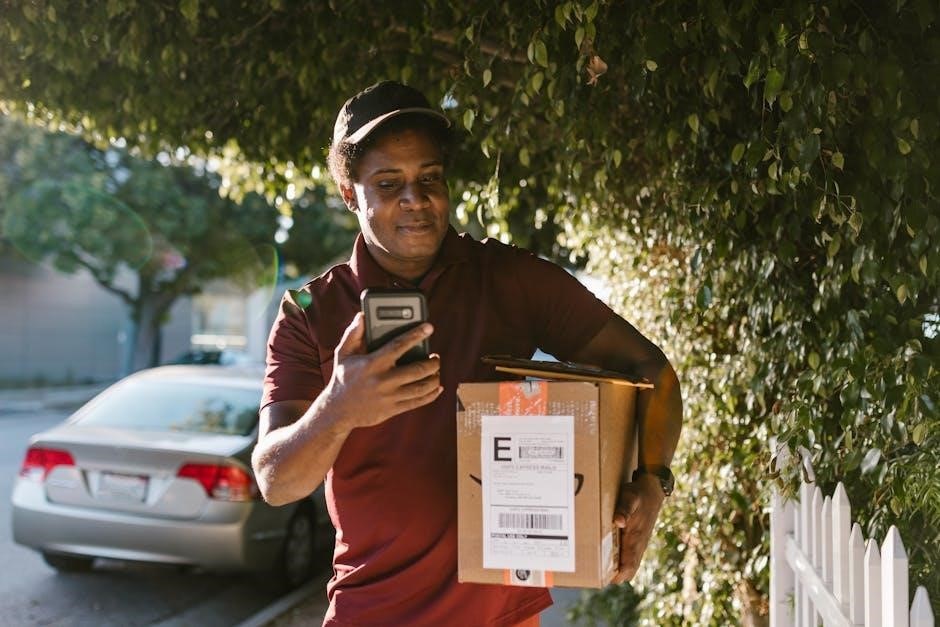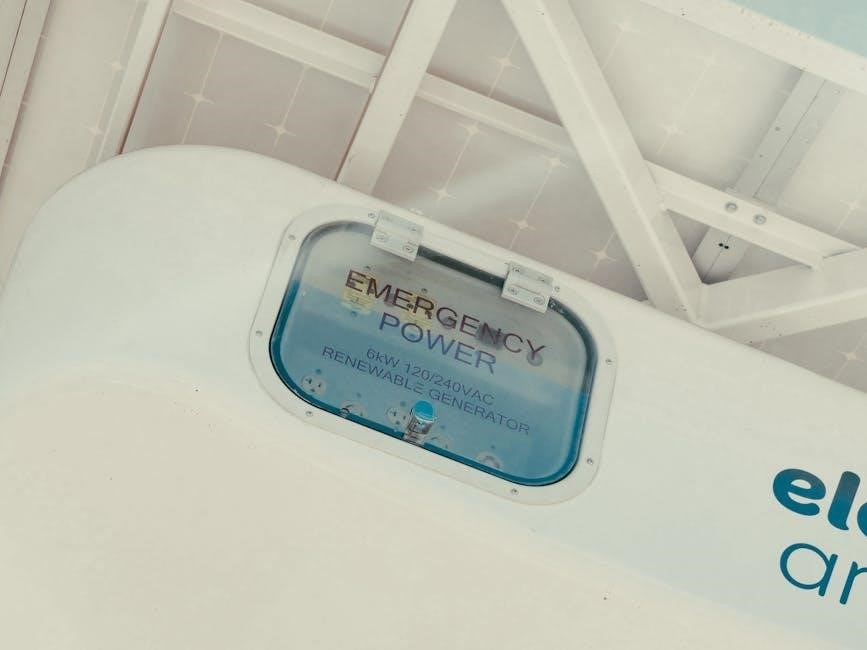Welcome to the American FarmWorks 5 Mile Solar Fence Charger Manual. This guide provides essential information for installing, operating, and maintaining your solar-powered fence charger efficiently and safely.
Overview of the Solar Fence Charger System
The American FarmWorks 5 Mile Solar Fence Charger System is a reliable, solar-powered solution for managing electric fences. It includes a fence energizer, solar panel, and grounding system. The energizer converts sunlight into energy, stored in a rechargeable battery, ensuring continuous power even during low-light conditions. The system is designed for durability and efficiency, providing up to 5 miles of coverage. Proper installation is crucial, with the solar panel and energizer ideally positioned for maximum sunlight exposure. The grounding system requires moist soil and appropriate materials like copper or galvanized rods. Insulated wire connects the components, ensuring safe and effective energy transfer. Regular maintenance, such as clearing vegetation and checking connections, is essential for optimal performance. This system is ideal for livestock management, offering a cost-effective and environmentally friendly alternative to traditional fencing solutions. Follow the manual for detailed setup and safety guidelines to ensure longevity and efficiency.
Importance of Proper Installation and Maintenance
Proper installation and maintenance are critical for the optimal performance and longevity of the American FarmWorks 5 Mile Solar Fence Charger. Incorrect setup can lead to reduced efficiency, equipment damage, or even safety hazards. Ensuring the solar panel is positioned for maximum sunlight exposure and the grounding system is correctly installed with moist soil and appropriate materials is vital. Regular inspections of the fence wire, connections, and battery are essential to prevent issues like improper grounding or power loss. Vegetation growth and weather conditions can affect performance, so periodic clearing and adjustments are necessary. Following the manual’s guidelines ensures the system operates safely and effectively, providing reliable livestock control and minimizing costly repairs. Proper care extends the lifespan of the charger and guarantees consistent energy delivery, making it a worthwhile investment for your property’s needs.

Key Features and Benefits of the American FarmWorks 5 Mile Solar Fence Charger
The American FarmWorks 5 Mile Solar Fence Charger offers a reliable, solar-powered solution for livestock management. It features a 5-mile range, lightweight design, and cost-saving efficiency.
5 Mile Range Coverage for Effective Livestock Management
The American FarmWorks 5 Mile Solar Fence Charger provides excellent coverage, ensuring your livestock remains securely contained within a 5-mile perimeter. Its robust solar-powered technology delivers consistent energy, even in challenging weather conditions. The system is designed to handle various terrains, making it ideal for large pastures or remote areas. With this range, you can effectively manage your herd without the need for multiple energizers, saving time and resources. Proper installation and grounding are crucial to maximize its performance. The charger’s reliability ensures that your fence remains active, keeping predators out and your livestock safe. This feature makes it a practical choice for farmers and ranchers seeking a durable and efficient fencing solution.

Solar-Powered Efficiency and Cost Savings
The American FarmWorks 5 Mile Solar Fence Charger offers exceptional solar-powered efficiency, providing reliable energy while reducing operational costs. By harnessing sunlight, it eliminates the need for external power sources, lowering electricity bills and minimizing reliance on non-renewable energy. The system’s solar panel charges an internal battery, ensuring continuous operation even during periods of low sunlight or at night. This eco-friendly design not only cuts down on energy expenses but also reduces maintenance, as there are no batteries to replace frequently. The charger’s efficient energy storage and usage make it a cost-effective solution for livestock management, offering long-term savings without compromising performance. Its lightweight and portable design further enhances its practicality for various farming applications.
Lightweight and Portable Design for Easy Installation
The American FarmWorks 5 Mile Solar Fence Charger features a lightweight and portable design, making installation and relocation straightforward. Weighing less than traditional chargers, it reduces the effort needed for setup, allowing farmers to position it optimally without additional tools. Its compact structure enables easy transportation, even in remote areas, ensuring flexibility for various fencing configurations. The solar panel is designed to be durable yet lightweight, with a simple mounting system that allows for quick adjustments. This portability is especially beneficial for farmers managing multiple pastures or needing to reconfigure fencing layouts. The unit’s ergonomic design ensures ease of handling, reducing strain during installation and maintenance, making it a practical choice for efficient livestock management.

Installation Steps for the American FarmWorks 5 Mile Solar Fence Charger
The American FarmWorks 5 Mile Solar Fence Charger installation process is straightforward, ensuring efficient and safe setup. Follow the manual for key steps and safety guidelines to ensure optimal performance.
Step 1: Choosing the Optimal Location for the Energizer and Solar Panel

Positioning the energizer and solar panel correctly is crucial for maximum efficiency. Ideally, place the energizer near the center of the fence to ensure even power distribution. Ensure the solar panel faces south to maximize sunlight exposure and avoid shading from trees or buildings. The location should be level and free from obstructions to allow proper drainage and airflow. Additionally, verify that the site provides good grounding conditions, such as moist soil or access to ground rods. Finally, ensure the location is accessible for maintenance and protected from potential damage or tampering. Proper placement ensures reliable performance and extends the lifespan of your solar fence charger system.
Step 2: Setting Up the Grounding System
A proper grounding system is essential for safe and effective operation of your solar fence charger. Begin by installing a ground rod made of copper or galvanized metal, ensuring it is at least 6 feet deep in moist soil. If soil conditions are poor, multiple rods spaced 10 feet apart may be necessary. Connect the ground rod to the energizer using insulated wire, ensuring all connections are secure and free from corrosion. Keep the area around the ground rod clear of debris and vegetation to maintain optimal conductivity. Proper grounding prevents electric shock and ensures the system functions correctly. Always follow safety guidelines when handling high-voltage components and test the ground system regularly to ensure reliability.
Step 3: Connecting the Energizer to the Fence and Ground System
Connect the energizer to the fence and ground system following these steps. First, locate the positive (fence) and negative (ground) terminals on the energizer. Attach the insulated hook-up wire to the positive terminal and secure it to the fence using appropriate connectors or clamps. Ensure the wire is tightly fastened to prevent voltage drops. Next, connect the ground terminal to the grounding system, ensuring all connections are secure and free from corrosion. Double-check that the fence and ground systems are properly linked, as this ensures safe and efficient operation. Always avoid touching the fence or energizer terminals during this process to prevent electric shock. Once connected, test the system to confirm proper voltage output using a fence tester.
Step 4: Testing the Fence Voltage with a Fence Tester
After connecting the energizer, use a fence tester to verify the voltage is within the recommended range. Place the tester on the fence wire, ensuring it makes good contact. A reading of 2,000 to 6,000 volts indicates proper operation. If the voltage is too low, check for issues like poor grounding, vegetation interference, or faulty connections. Test multiple points along the fence to ensure consistent voltage distribution. Avoid touching the fence or tester during this process to prevent electric shock. Regular testing helps maintain fence performance and ensures livestock containment. Always follow safety guidelines when handling electrical components. Proper voltage levels are crucial for effective livestock management and system longevity.

Step 5: Powering the Fence Energizer
To power the fence energizer, ensure the switch is in the ON position. The energizer will automatically begin charging the internal battery using solar power. Always avoid touching the fence terminal or wire during this process to prevent electric shock. Once powered, the system will operate continuously, providing reliable voltage to your fence. For optimal performance, position the solar panel in direct sunlight and ensure it is free from obstructions. Regularly check the battery charge level, especially during periods of limited sunlight. The energizer is designed to operate automatically, requiring minimal intervention once properly set up. Follow all safety guidelines to ensure safe and effective operation of the solar fence charger.

Safety Precautions When Working with Electric Fence Chargers
Always handle high-voltage components with caution to avoid electric shock. Wear insulated gloves and avoid touching terminals or wires while the energizer is powered. Ensure proper grounding and follow all safety guidelines during installation and testing to minimize risks. Regularly inspect the system for damage or wear to maintain safe operation. Keep children and pets away from the fence and energizer to prevent accidental contact. Never attempt repairs while the system is live. Follow the manufacturer’s instructions and safety protocols at all times to ensure safe and effective use of the electric fence charger.
Understanding Electric Shock Risks and Prevention
Electric shock from fence chargers can be dangerous, so understanding risks and prevention is crucial. Always disconnect the energizer before handling wires or components. Use insulated gloves and tools to minimize contact with live parts. Ensure the system is properly grounded to prevent voltage buildup. Avoid working on the fence in wet conditions, as moisture increases conductivity. Keep the area clear of debris and vegetation that could cause unintended electrical paths. Regularly test voltage levels with a fence tester to ensure safe operation. Never touch the fence or terminals while the system is active. Following these precautions reduces the risk of electric shock and ensures safe use of your American FarmWorks 5 Mile Solar Fence Charger.

Proper Handling of High-Voltage Components

Handling high-voltage components of the American FarmWorks 5 Mile Solar Fence Charger requires caution to ensure safety. Always disconnect the energizer from the power source before servicing or adjusting any parts. Use insulated gloves and tools to prevent direct contact with live wires or terminals. Avoid touching electrical components with bare hands, as this can lead to electric shock. Ensure the system is properly grounded and de-energized before performing any maintenance. Regularly inspect wires and connections for damage or wear, and replace them if necessary. Never attempt to bypass safety features or modify the system beyond manufacturer recommendations. Proper handling and care of high-voltage components will ensure reliable performance and minimize risks associated with electric fencing systems.
Safety Guidelines for Testing and Troubleshooting
Safety Guidelines for Testing and Troubleshooting
When testing and troubleshooting the American FarmWorks 5 Mile Solar Fence Charger, prioritize safety to avoid potential risks. Always use a fence tester to measure voltage safely without direct contact with live wires. Ensure the energizer is powered off before inspecting or repairing any components. Wear insulated gloves and avoid working in wet conditions to reduce shock hazards. Keep the area clear of livestock and bystanders while testing. If voltage levels are inconsistent, check for improper grounding or vegetation interference. Refer to the manual for specific troubleshooting steps, and never bypass safety features or attempt unauthorized repairs. Following these guidelines ensures safe and effective testing and troubleshooting of your solar fence charger.

Maintenance and Troubleshooting Tips
Regularly inspect the fence and ground system for damage or corrosion. Address issues like improper grounding or vegetation interference promptly to ensure optimal performance and safety.
Regular Inspection of the Fence and Ground System
Regular inspection of the fence and ground system is crucial for ensuring optimal performance and safety. Start by visually examining the fence wires for any signs of damage, wear, or corrosion. Check for loose connections or broken strands, as these can significantly reduce the effectiveness of the electric fence. Next, inspect the ground system, ensuring that the ground rods are properly installed and free from corrosion. Verify that the soil moisture levels are adequate, as dry soil can impede the flow of electric current. Additionally, look for any vegetation or debris that may be interfering with the fence or ground system, as this can cause performance issues. Perform these inspections at least monthly and after severe weather events to maintain reliability and prevent potential hazards. Regular checks will help identify and address problems early, ensuring your solar fence charger operates efficiently and safely.
Addressing Common Issues Like Improper Grounding
Improper grounding is one of the most common issues affecting the performance of your American FarmWorks 5 Mile Solar Fence Charger; To address this, ensure the ground system is correctly installed with copper or galvanized metal rods driven at least 6 inches deep into moist soil. Check that the ground rods are spaced 10 feet apart and free from corrosion. If the soil is dry, consider watering the area around the rods to improve conductivity. Additionally, verify that all connections between the energizer, fence, and ground system are secure and free from damage. Regularly inspect the ground system for any signs of wear or interference from vegetation. Addressing grounding issues promptly will ensure your solar fence charger operates effectively and safely, maintaining consistent voltage levels across the fence. Proper grounding is essential for the system’s reliability and longevity.
Dealing with Environmental Factors Affecting Performance
Environmental factors such as vegetation growth, snow, and sunlight exposure can impact the performance of your American FarmWorks 5 Mile Solar Fence Charger. Regularly inspect the fence line to ensure it is free from brush and overgrowth, as these can cause short circuits and reduce efficiency. During winter months, snow accumulation on the solar panel can block sunlight, reducing charging capacity. Clear the panel regularly to maintain energy generation. Additionally, ensure the solar panel is positioned to receive maximum sunlight, avoiding shaded areas. Extreme weather conditions, such as heavy rain or hail, can also affect performance, so inspect the system after storms for damage. Addressing these environmental challenges will help maintain consistent voltage and ensure the longevity of your solar fence charger. Proper care and attention to these factors are essential for optimal functionality. Regular maintenance will keep your system running smoothly year-round.
Maximizing the Lifespan of Your Solar Fence Charger
Proper installation, regular maintenance, and storage ensure the longevity of your American FarmWorks 5 Mile Solar Fence Charger. Position the energizer and solar panel centrally, avoid shaded areas, and use a sturdy fence design for optimal performance and durability.
Factors Influencing the Longevity of the Charger
The lifespan of the American FarmWorks 5 Mile Solar Fence Charger depends on sunlight exposure, usage frequency, and maintenance. Ensure the solar panel is positioned to receive maximum sunlight, avoiding shade, and clean it regularly to maintain efficiency. Proper grounding and insulation of wires are crucial to prevent energy loss and damage. Additionally, storing the charger in a dry, cool place during off-seasons and protecting it from extreme weather conditions will extend its life. Regularly inspect the unit and replace worn-out components promptly to ensure optimal performance and longevity.
Best Practices for Storage and Maintenance
Store the American FarmWorks 5 Mile Solar Fence Charger in a dry, cool place during off-seasons to protect it from moisture and pests. Before storage, clean the solar panel and ensure all connections are secure. Disconnect the battery and store it separately in a cool, dry area, avoiding extreme temperatures. Regularly inspect the unit for wear and tear, replacing any damaged components promptly. Maintain proper grounding and insulation of wires to prevent energy loss. For optimal performance, test the fence voltage periodically using a fence tester and address any issues immediately. Proper storage and maintenance ensure the charger remains efficient and reliable for years. Always follow the manufacturer’s guidelines for storage and maintenance to preserve the product’s longevity and functionality.
Warranty and Registration Information
Register your American FarmWorks 5 Mile Solar Fence Charger online at www.zarebasystems.com immediately after purchase to activate your warranty. Keep your receipt as proof of purchase, as it may be required for warranty claims. The warranty covers defects in materials and workmanship for a specified period. For detailed warranty terms, visit the manufacturer’s website or contact customer support at 855-5-ZAREBA. Proper installation and maintenance are essential to uphold warranty validity. For any issues, refer to the user manual or download the PDF version from the official website. Ensure all repairs are conducted by authorized personnel to avoid voiding the warranty. Regular updates and support are available online to help you maintain your solar fence charger effectively.
Welcome to the conclusion of the American FarmWorks 5 Mile Solar Fence Charger Manual. Proper installation, maintenance, and safety practices ensure optimal performance and longevity of your solar fence charger.
Final Thoughts on Effective Solar Fence Charger Usage
Effective use of the American FarmWorks 5 Mile Solar Fence Charger involves proper installation, regular maintenance, and adherence to safety guidelines. Positioning the energizer and solar panel strategically ensures maximum energy absorption. Grounding is critical to prevent voltage loss and potential hazards. Testing fence voltage regularly guarantees the system operates within safe and effective parameters. Environmental factors like snow and vegetation can impact performance, so maintaining the fence and surrounding areas is essential. By following these practices, you can ensure reliable operation and extend the lifespan of your solar fence charger. Always refer to the manual for troubleshooting and to address common issues promptly. Safe and efficient use of the charger will help manage your livestock effectively while minimizing costs and environmental impact.
Encouragement for Proper Maintenance and Safety
Proper maintenance and safety practices are crucial for ensuring the longevity and effectiveness of your American FarmWorks 5 Mile Solar Fence Charger. Regularly inspecting the fence and grounding system helps prevent issues like improper grounding or voltage loss. Clearing vegetation and debris around the solar panel and fence wires optimizes performance and safety. Always use a fence tester to verify voltage levels and avoid touching live components to prevent electric shock. Following the manual’s guidelines ensures safe operation and maximizes the charger’s efficiency. By prioritizing maintenance and adhering to safety protocols, you can protect your livestock, property, and equipment while enjoying the benefits of a reliable solar-powered fencing system. Consistent upkeep not only enhances performance but also ensures a safer environment for both animals and people.
